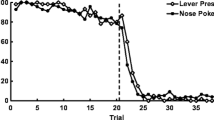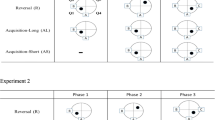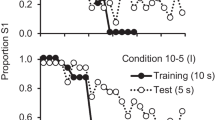Abstract
Rats were runway trained with sequences of rewards that changed in 3 phases. In Phase 1 (24 days), the sequences were NP, SNP’, and P’SNP’ (n = 3), or IMS’, PNS’, and S’PNS’, where P and P’ refer to 4 and 8 plain Noyes pellets, and S and S’ are 4 and 8 sucrose pellets. N was a 30-s confinement in the goal without reward. In Phase 2 (14 days) the animals were trained either SNP’ or PNS’ depending upon compatibility with the Phase 1 training series. A test for control of performance by reward-memory associations or position associations occurred in Phase 3 (2 days). The test series was a transfer NNN. Controls were not trained in Phase 1, but received training in Phase 2 (24 days) with either SNP’ (n = 3) or PNS’ (n = 3). In Phases 1 and 2, responding was slower on N trials than on rewarded trials. In Phase 3 controls responded slower on the second trial of NNN than on the initial or final trials. The animals trained in all 3 phases showed either the same pattern as the controls in the NNN test (n = 4) or approached all 3 NNN trials rapidly (n = 2). The findings illustrate the difficulty of blocking position learning by training with reward-memory associations.
Similar content being viewed by others
References
BURNS, R. A., & CRIDDLE, C. R. (2001). Retention of ordinal position information with limited and extended training. The Psychological Record, 51, 445–452.
BURNS, R. A., DUNKMAN, J. A., JR., & DETLOFF, S. L. (1999). Ordinal position in the serial learning of rats. Animal Learning & Behavior, 27, 272–279.
BURNS, R. A., JOHNSON, K. S., HARRIS, B. A., KINNEY, B. A., & WRIGHT, S. E. (2004). Functional cues for position learning effects in animals. The Psychological Record, 54, 233–254.
BURNS, R. A., KINNEY, B. A., & CRIDDLE, C. R (2000). Position cues and reward memories as compatible components of serial learning. Learning & Motivation, 31, 236–250.
BURNS, R. A., & SANDERS, R. E. (1987). Concurrent counting of two and three events in a serial anticipation paradigm. Bulletin of the Psychonomic Society, 25, 479–481.
CAPALDI, E. J., ALPTEKIN, S., MILLER, D. J., & BIRMINGHAM, K. M. (1997). Is discriminative responding in reward outcome serial learning mediated by item memories or position cues?. Learning and Motivation, 28, 153–169.
CAPALDI, E. J., & MILLER, D. J. (1988). Counting in rats: Its functional significance and the independent cognitive processes which comprise it. Journal of Experimental Psychology: Animal Behavior Processes, 14, 3–17.
CAPALDI, E. J., & MILLER, R. M. (2001). Stimulus control of anticipatory responding in instrumental learning as revealed in serial learning tasks. Animal Learning & Behavior, 29, 165–175.
CAPALDI, E. J., & MOLINA, P. (1979). Element discriminability as a determinant of serial-pattern learning. Animal Learning & Behavior, 7, 318-322.
DAMATO, M. R. (1991). Comparative cognition: Processes of serial order and and serial pattern. In L. Dachowski & C. F. Flaherty (Eds.), Current topics in rat learning: Brain, emotion, and cognition (pp. 165–185). Hillsdale, NJ: Erlbaum.
KAMIN, L. J. (1968). “Attention-like” processes in classical conditioning. In M. R. Jones (Ed.), Miami symposium on the prediction of behavior: Aversive stimulation (pp. 9–31). Miami: University of Miami Press.
NEATH, I., & CAPALDI, E. J. (1996). A “random walk” simulation model of multiple-pattern learning in a radial-arm maze. Animal Learning & Behavior, 24, 206–210.
PAVLOV, I. P. (1927). Conditioned reflexes. Oxford, UK: Oxford University Press.
ROITBLAT, H. L., POLOGE, B., & SCOPATZ, R. A. (1983). The representation of items in serial position. Animal Learning & Behavior, 11, 489–498.
Author information
Authors and Affiliations
Corresponding author
Additional information
This work was supported by a Grants and Research Funding grant from Southeast Missouri State University. We thank Courtney M. Eklund for her assistance in data collection.
Rights and permissions
About this article
Cite this article
Burns, R.A., Johnson, K.S. An Attempt at Blocking of Position Learning by Training with Reward-Memory Associations. Psychol Rec 56, 569–576 (2006). https://doi.org/10.1007/BF03396034
Published:
Issue Date:
DOI: https://doi.org/10.1007/BF03396034




